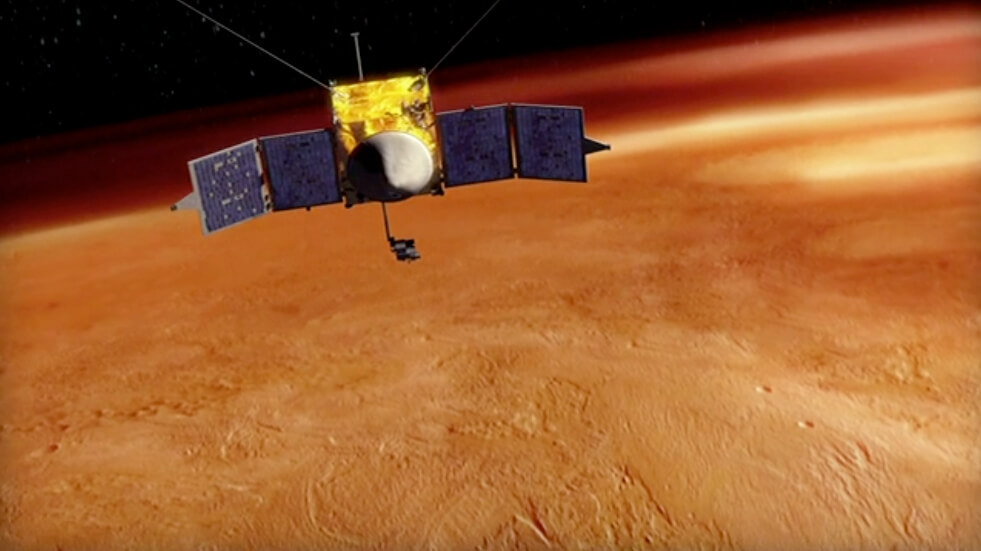- Get link
- X
- Other Apps

NASA Aerospace Agency is finalizing its preparations for the start of a new space research mission, which will start on Monday, November 18. On this day, the Mars Atmosphere and Volatile EvolutioN (Evolution of the Atmosphere and Volatile Matter on Mars) or MAVEN satellite will launch from the US Air Force base at Cape Canaveral. As the name of the satellite suggests, the spacecraft will measure the composition of the atmosphere of the Red Planet from its orbit, which will help scientists better understand how the climate has changed so much over the past billions of years. The satellite will reach Mars 10 months after its launch from the Earth and arrive in the orbit of the Red Planet in September 2014.
Space.com decided to prepare 5 key facts that you need to know about MAVEN and its mission, worth 671 million dollars.
MAVEN is a rather large satellite.
Working on the basis of solar batteries, MAVEN turned out to be a rather large satellite. The dimensions of the main part of the satellite in the form of a cube are 2.4 meters. With open solar panels, its size increases to 11.4 meters, which makes it similar in size to a bus. The weight of the MAVEN is 2454 kilograms.
In elliptical orbit
When MAVEN reaches Mars, the probe will begin its revolution around the planet in an elliptical orbit. In this case, the minimum distance to the surface of the planet will be 150 kilometers, and the maximum - 6000 kilometers. In addition, the probe is going to go through five “deep-sea passes” at an altitude of 124 kilometers in the atmosphere of the Red Planet and collect the necessary samples that will help scientists better create a picture of the mix of the lower and upper layers of the atmosphere of Mars.
Solving Martian Mysteries
Scientists assume that many millions of years ago there could have been life on Mars when the planet had a denser atmosphere and water on its surface. But then something happened and the Red Planet turned into a lifeless, cold and dry world that we know today thanks to the Martian rovers plowing its surface. At the moment, the density of the atmosphere of Mars is only one percent of the density of the Earth’s atmosphere.
Scientists hope that MAVEN will help them determine the cause of such a terrible transformation. The mission of the mission is to determine how and why Mars has lost almost all of its atmosphere and what role the climate changes in the Red Planet over the past 4 billion years have played in this loss. For these purposes, MAVEN will use eight different scientific tools that will help it in studying the upper layers of the planet’s atmosphere, solar winds affecting it, streams of charged solar particles, which scientists assume are one of the causes of drying and evaporation of water on Red the planet.
MAVEN will not search for life on Mars
It is important to understand that MAVEN is not going to look for life on the Red Planet. The satellite is more likely to study the environment in which life could exist in the past and present. In fact, MAVEN is not even equipped with a detector for detecting methane, a gas that could indirectly tell us about the possibility of extraterrestrial life (an interesting fact after it: about 90 percent of methane on Earth is produced by living organisms). Unfortunately, as scientists report, the MAVEN budget was not designed to install such a detector.
Communication link
At NASA, not only are they rubbing their hands with impatience to get the first research data from MAVEN, but they are also happy that the research apparatus will be able to serve the space agency in another matter - it will become a communication link between the Martian rovers on the surface of the planet and the team of operators here on Earth. At the moment, NASA on Mars has two rovers - the rover "Curiosity" the size of a small car that landed on the surface of the Red Planet in August 2012, as well as a more compact size rover "Oportyunity", the old man who sat down on the planet in January 2004. Now data from two robots is collected by two satellites - Mars Odyssey, launched in 2001, and Mars Reconnaissance Orbiter (MRO), launched in 2005 and launched into the orbit of the Red Planet in 2006. Next year they will be joined by MAVEN.

Assembling the Martian satellite MAVEN
These communication tasks entrusted to him helped the MAVEN project to remain afloat, even though the US government defaulted last month, causing NASA to send 97 percent of its staff on unpaid leave, and most projects to close or freeze indefinitely. Fortunately, even within the framework of this default, which lasted 17 days, the agency managed to beat out funding to continue work on MAVEN and prepare it for launch.
The article is based on materials .
- Get link
- X
- Other Apps
Comments
Post a Comment